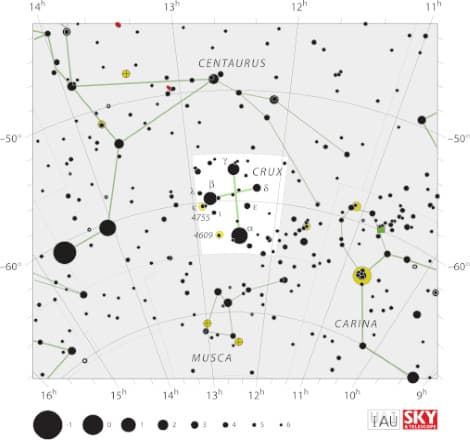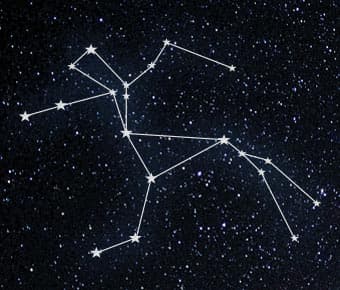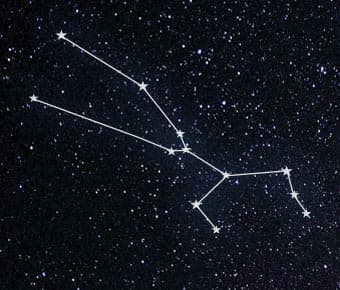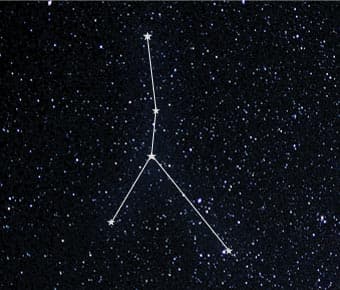Do you know your asterisms from your constellations? Don’t worry if not. You will learn the key difference in this Crux constellation guide. We cover everything to do with the smallest constellation in the sky, and one that the Greeks forgot to mention – right here.
We will even tell you how to see the Crux constellation from the UK. Let’s shoot on!
Crux Mythology Explained
Ancient Greek peoples considered the Crux constellation as part of the Taurus constellation. This is evidenced in Claudius Ptolemy’s famous Almagest written in the 2nd century. His work was a recording of the constellations, but in it, Crux is not mentioned. Instead, the stars of Crux are labelled within Taurus. This is why there is no known Greek mythical figure associated with the Crux constellation.
Nevertheless, the Crux constellation – which is sometimes called the southern cross – has significant importance to peoples in the Southern Hemisphere. The famous Machu Picchu area in the Andes mountains is home to a historic stone carving of the Crux constellation. In Australian aboriginal astronomy, part of the constellation is used to create an Emu and the cross features on the national flag. Whereas in Brazil, the constellation gets an honorary mention in its national anthem – and is also seen on the national flag.
It appears that the crux constellation was not as recognised or treasured in countries in the Northern Hemisphere as it was in the south. This has resulted in fewer (European) mythologies associated with it.

Source: Wikipedia
- Symbolism: Southern Cross
- Right ascension: 12.5h
- Declination: −60°
- Quadrant: SQ3
- Area: 68 sq. deg. (88th)
- Main stars: 4
- Bayer/Flamsteed stars: 19
- Stars with planets: 2
- Brightest star: Acrux (α Cru) (0.87m)
The Appearance of the Crux Star Constellation
Within the Crux constellation is an asterism. An asterism is an easily recognised shape or image made by the stars – not the same as a constellation. The Crux constellation includes a cross asterism made up of four stars, although a fifth star is often added. It should be said that this cross is not the constellation as a whole, only part of the constellation. The Crux constellation contains tens of main stars while this cross is just a segment of those stars. This is why some people call it the cross constellation or the southern cross.
Major Stars of the Cross Constellation
Nevertheless, the main stars of the Crux constellation are the ones that make up the cross asterism. These are the brightest stars of the constellation. The brightest of them all is called Acrux. This is the star you can find on many national flags, and it represents some states in many countries. The other stars that make up the cross asterism are called:
- Mimosa
- Gacrux
- Imai
- Ginan (this is the fifth star that sometimes gets left out when describing the asterism)
The Location of the Crux Constellation
The Crux constellation is the smallest of the 88 modern constellations recognised today. It measures in at just 68 square degrees. The Taurus constellation wraps around Crux on three of its boundaries, which is probably why the Greeks used to class these stars as part of Taurus.
To be more scientific, the Crux constellation is situated in the Southern Hemisphere’s third quadrant (SQ3), making it visible between latitudes of +20 and -90 degrees. The other nearby constellation to Crux is called Musca, which means fly in Latin.
Are You looking for the Crux Constellation from the UK?
If the Crux constellation is in the Southern Hemisphere, does that make it not visible from the UK? The answer is no. There are still times of the year when you can see the cross constellation from the UK – but you need to know when to go searching for it.
You will be able to see the Crux constellation in May if the sky is clear and you get into a good position. This means escaping the bright city lights or any other urban light pollution. Because the cross asterism stands out, this constellation can be found by novice stargazers easily.
If you miss your chance, there are plenty of constellations visible from the UK all year long. Check out our other constellation guides to see what else you can see in the UK sky.
How Far Away Is the Famous Cross Constellation?
It is not possible to say how far away the Crux constellation, or even just the cross asterism, is from Earth. Constellations are made up of many stars and it would be incredible luck if all of these stars were the same distance away. Most stars are great distances from each other, but this can be difficult to understand because stars can look really close to each other.
For example, the four stars most often associated with the cross asterism are 321, 353, 264 and 345 light years away from Earth. Some stars can be even greater distances from each other, up to hundreds of light years apart.
More Southern Cross Constellation Facts
Do you know the other flags which boast the cross asterism of the Crux constellation? Learn these and other constellation facts below.
- From 400AD, the Crux constellation could not be seen in Europe anymore. It was rediscovered centuries later.
- The cross asterism appears on even more than the Brazil and Australian flags. It has or still appears on the flags of New Zealand, Samoa, Papua New Guinea. Australians will even see it at rail terminals in Melbourne.
- There is a debate about who separated Crux from Taurus in Europe. While there is a case that it was a French astronomer called Augustin Royer, others suggest it occurred around 50 years earlier by a Dutchman named Petrus Plancius.
Looking for constellations that include an asterism is a lot of fun. You can make your stargazing adventures even more awesome by naming the stars after your friends, family or special someone.
Learn how to name a star at the Star Name Registry! – and you may just become a star in someone else’s eyes!






